-
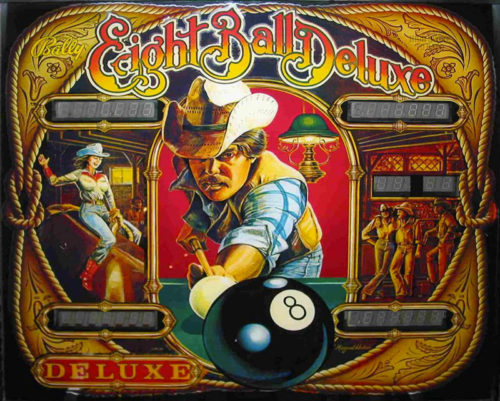 This game was very successful for the Bally company. It was initially released in 1981 as a full upright pinball with a production of 8,250 games. This version of the game in its third release had a run of 8,850 games. This cabinet was a unique design for Bally, as was used in a few other games like Pac-Man pinball. Designed by George Christian with art by Margaret Hudson, the pool-themed game is a classic. The basic object here is to hit all seven drop targets representing pool balls. The eight-ball drop target then pops up. Upon hitting it, “deluxe” lights up behind where the drop targets were. Making “deluxe” increases your bonus upon completion of the ball and advances the deluxe hold-over feature on the backglass. Hitting the in-line drop targets awards points and specials. The same is true if you shoot the left ramp to the top.
This game was very successful for the Bally company. It was initially released in 1981 as a full upright pinball with a production of 8,250 games. This version of the game in its third release had a run of 8,850 games. This cabinet was a unique design for Bally, as was used in a few other games like Pac-Man pinball. Designed by George Christian with art by Margaret Hudson, the pool-themed game is a classic. The basic object here is to hit all seven drop targets representing pool balls. The eight-ball drop target then pops up. Upon hitting it, “deluxe” lights up behind where the drop targets were. Making “deluxe” increases your bonus upon completion of the ball and advances the deluxe hold-over feature on the backglass. Hitting the in-line drop targets awards points and specials. The same is true if you shoot the left ramp to the top. -
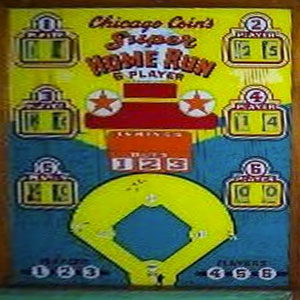
-
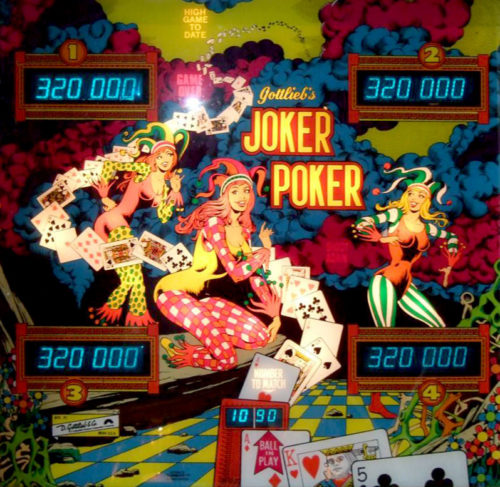 Gottlieb Joker Poker pinball. An interesting design, and only made in a 4 player version (no 2 player, unusual for Gottlieb pinball). One bank of five ace drop targets, one bank of four king drop targets, one bank of three jack targets, one bank of two queen drop targets, and a single ten drop target. Pretty cool pinball design really. Two pop bumpers, one slingshot, two 3″ flippers. They made 820 Gottlieb EM Joker Poker pinballs.
Gottlieb Joker Poker pinball. An interesting design, and only made in a 4 player version (no 2 player, unusual for Gottlieb pinball). One bank of five ace drop targets, one bank of four king drop targets, one bank of three jack targets, one bank of two queen drop targets, and a single ten drop target. Pretty cool pinball design really. Two pop bumpers, one slingshot, two 3″ flippers. They made 820 Gottlieb EM Joker Poker pinballs. -
 Williams produced this game in October with 7,053 units produced. Norm Clark designed the game and Christian Marche did the art package. This four-player electromechanical game is based on the game tic-tac-toe. Making 3 x’s or 3 o’s in line or diagonally lights the eject holes to award an extra ball and 5,000 points. Making the A and B rollovers lights the center target. Hitting it opens the gate and 1,000 points. A bonus feature is incorporated into the game and this is awarded when the ball drains. Lighting all the squares activates the side rollover lanes to score a replay. Score and matching are also incorporated into the game. A fast playfield design and fun to play.
Williams produced this game in October with 7,053 units produced. Norm Clark designed the game and Christian Marche did the art package. This four-player electromechanical game is based on the game tic-tac-toe. Making 3 x’s or 3 o’s in line or diagonally lights the eject holes to award an extra ball and 5,000 points. Making the A and B rollovers lights the center target. Hitting it opens the gate and 1,000 points. A bonus feature is incorporated into the game and this is awarded when the ball drains. Lighting all the squares activates the side rollover lanes to score a replay. Score and matching are also incorporated into the game. A fast playfield design and fun to play. -
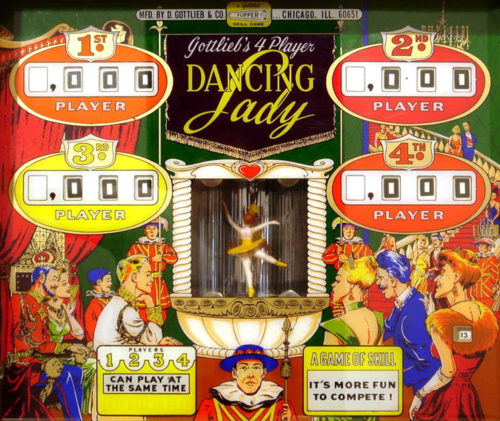 This four-player machine was produced in November of the year with 2,675 units fabricated. It was designed by Ed Krynski with art penned by Art Stenholm. Technically, a couple of firsts were incorporated into this machine for Gottlieb, like an automatic ball lifter, decagon score reels and carousel roto-targets. The carousel roto-target allow one to shoot at one or two targets at a time if flipper savvy. The star on the unit awards an extra ball. The object of the game is to achieve high-enough scores to award replays. The big points are awarded when the two 10x lights under a roto-target light up, awarding 100 times the value of the number hit. The most attractive gadget built into the game is the dancing ballerina in the backglass, which dances when certain elements of the play field are achieved. A highly collectible game in its own right.
This four-player machine was produced in November of the year with 2,675 units fabricated. It was designed by Ed Krynski with art penned by Art Stenholm. Technically, a couple of firsts were incorporated into this machine for Gottlieb, like an automatic ball lifter, decagon score reels and carousel roto-targets. The carousel roto-target allow one to shoot at one or two targets at a time if flipper savvy. The star on the unit awards an extra ball. The object of the game is to achieve high-enough scores to award replays. The big points are awarded when the two 10x lights under a roto-target light up, awarding 100 times the value of the number hit. The most attractive gadget built into the game is the dancing ballerina in the backglass, which dances when certain elements of the play field are achieved. A highly collectible game in its own right. -
 This “special edition” game was produced to recognize the fact that this game, when initially released two years earlier, was the biggest number production game ever made in the contemporary era, with a total production run of 20,270. This game was produced in 1,000 examples. Pat Lawlor designed the machine with John Youssi getting accolades for the artwork. Gadgets abound in this machine, which is augmented by the gold detailing over the standard unit. The main theme here is to complete all 12 parts of the house panel. Doing so brings you to the ultimate level of excitement. Multi-ball options abound as well as “Thing”, consisting of just a hand, grabbing the ball in the upper-right corner of the machine. A magnet under the play field provides strange ball play as well as Thing “flipping” the ball remotely if hit. The sounds and art are fantastic representations from the movie of the same name. This game is #3!
This “special edition” game was produced to recognize the fact that this game, when initially released two years earlier, was the biggest number production game ever made in the contemporary era, with a total production run of 20,270. This game was produced in 1,000 examples. Pat Lawlor designed the machine with John Youssi getting accolades for the artwork. Gadgets abound in this machine, which is augmented by the gold detailing over the standard unit. The main theme here is to complete all 12 parts of the house panel. Doing so brings you to the ultimate level of excitement. Multi-ball options abound as well as “Thing”, consisting of just a hand, grabbing the ball in the upper-right corner of the machine. A magnet under the play field provides strange ball play as well as Thing “flipping” the ball remotely if hit. The sounds and art are fantastic representations from the movie of the same name. This game is #3! -
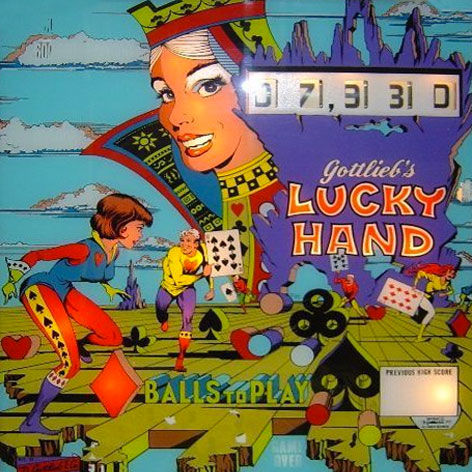
-
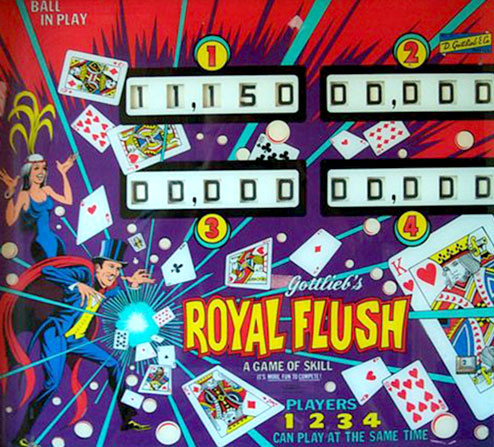 This April release came in a four-player version, also in the museum called “Royal Flush.” 12,250 games were created in this sizable run of machines. Ed Krynski designed the machine with Gordon Morison penning the artwork for the game. A very popular game in its day, the main ingredient of the play field is the battery of nine drop targets set at an angle. The object here is to complete the drop targets to complete the five card combinations represented on the front play field. Completing a combo illuminates the light in the bonus column of combos and at the end of the ball, a “scan” bonus would score the appropriate number of points to the player currently up. The drop targets reset after each ball unless an extra ball is scored via the free ball gate. A double scan of the bonus lights on the last ball. Another feature to shoot for is the three colored card sequence. These light a special on the kick-out hole.
This April release came in a four-player version, also in the museum called “Royal Flush.” 12,250 games were created in this sizable run of machines. Ed Krynski designed the machine with Gordon Morison penning the artwork for the game. A very popular game in its day, the main ingredient of the play field is the battery of nine drop targets set at an angle. The object here is to complete the drop targets to complete the five card combinations represented on the front play field. Completing a combo illuminates the light in the bonus column of combos and at the end of the ball, a “scan” bonus would score the appropriate number of points to the player currently up. The drop targets reset after each ball unless an extra ball is scored via the free ball gate. A double scan of the bonus lights on the last ball. Another feature to shoot for is the three colored card sequence. These light a special on the kick-out hole. -

-
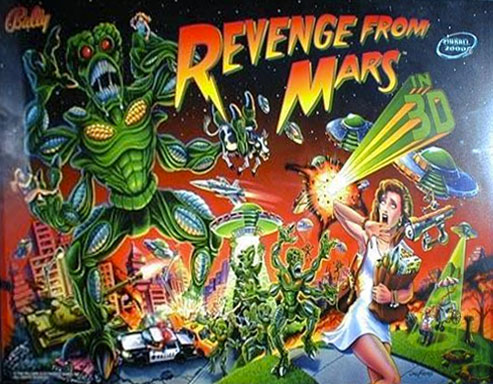 This is the next-to-last machine Williams made under the Bally moniker and the first game made to “reinvent” pinball in a last-ditch effort to save Williams from ceasing pinball manufacturing. 6,878 machines were made. George Gomez designed the new platform with Greg Freres and John Youssi designing the art package. This is Star Wars; the last games from Williams were the most technologically advanced games pinball has ever known. The incorporation of a reflecting video monitor with interactive playfield video feedback is revolutionary. The top of the playfield is mostly hidden from view except for a few selectively placed spots which light on occasion. This machine consists of nine different modes which must be conquered to proceed to the ultimate mode, that being the destruction of Mars. A very different game that sold well. However, Williams pulled the plug on pinball and thereafter focused on slot machines.
This is the next-to-last machine Williams made under the Bally moniker and the first game made to “reinvent” pinball in a last-ditch effort to save Williams from ceasing pinball manufacturing. 6,878 machines were made. George Gomez designed the new platform with Greg Freres and John Youssi designing the art package. This is Star Wars; the last games from Williams were the most technologically advanced games pinball has ever known. The incorporation of a reflecting video monitor with interactive playfield video feedback is revolutionary. The top of the playfield is mostly hidden from view except for a few selectively placed spots which light on occasion. This machine consists of nine different modes which must be conquered to proceed to the ultimate mode, that being the destruction of Mars. A very different game that sold well. However, Williams pulled the plug on pinball and thereafter focused on slot machines. -
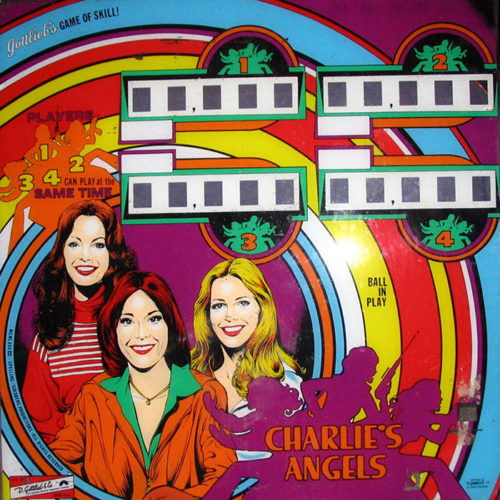
-
